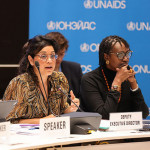A new Joint United Nations Programme on HIV/AIDS (UNAIDS) report indicates that an estimated 20.9 million people living with HIV worldwide were on antiretroviral (ARV) treatment as of June 2017. This figure is up from 19.5 million people at the end of 2016 and means that an estimated 17.1 million people with the virus remain off ARVs, including 1.2 million children.
UNAIDS released its Right to Health report in anticipation of World AIDS Day, which is December 1. The report states that an estimated 1.8 million people contracted HIV in 2016, which represents a 39 percent decrease from the peak rate of 3 million per year seen in the late 1990s. Sub-Saharan Africa has benefited from a 48 percent drop in its annual new infection rate since 2000, thanks to the aggressive scale-up of HIV treatment access in the years since then.
An estimated 1 million people died of AIDS-related causes in 2016.
While key measures of the overall worldwide epidemic are improving, there are trouble spots. In particular, Eastern Europe and Central Asia, a region made up largely of former Soviet republic, the new HIV infection rate has actually soared by 60 percent since 2010 while AIDS-related deaths have risen by 27 percent.
In 2014, UNAIDS called upon nations to get 90 percent of their HIV population diagnosed, 90 percent of that group on treatment and 90 percent of that group virally suppressed. According to UNAIDS modeling, hitting these 90-90-90 targets by 2020 would set the global epidemic on a path to end as a major public health threat by 2030.
Currently, an estimated 70 percent of the global HIV population is diagnosed, 77 percent of that group is on treatment and 82 percent of that group is virally suppressed. In other words, a respective 53 percent and 43 percent of the global HIV population is taking ARVs and is virally suppressed. To hit all three of the 90-90-90 targets given the size of today’s HIV population, an estimated 7.5 million more people need to be diagnosed, 10.2 million need to get on ARVs and 10.8 million need to achieve viral suppression.
Half of all people receiving ARVs globally live in just seven nations, according to UNAIDS. These countries include South Africa, which accounts for 20 percent of the total, as well as India, Mozambique, Kenya, Zimbabwe, Nigeria and Uganda, which account for 5 percent apiece.
To read a press release about the report, click here.
To read the report, click here.







Comments
Comments